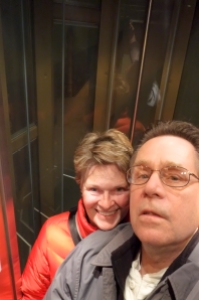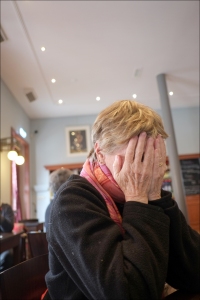The Great, the SoSo and the Run Like Hell
Before we got to Vienna we purchased lots of books about the city and it’s many attractions. Between these books and the many articles we’re read there have been tons of Top 10 lists. I thought it might be fun, for me at least, to review our most memorable 10. By way of a disclaimer I should point out that there probably isn’t anybody in the world that would agree with me. Even my wife thinks I’m full of malarkey.

The City
The Economic Intelligence Unit (EIU) does an annual Liveabilty Survey. With it’s low crime rate, great transportation system, sophisticated culture and architecture, Vienna is considered the second most livable city in the world. A little crowded at times but still nonthreatening, comfortable and easy to get around, it’s packed with great things to see. We loved it.

Downtown Vienna


Photo by Wendi


Fiaker Photo by Wendi

These are to secure your dog while you are in the shop.

I don’t think these things serve any purpose.

A shout out to Bart




The Belvedere
Completed in 1723 as a summer residence for Prince Eugen of Savoy, this was the most ambitious building project ever undertaking by a private individual. It is now home to some of Austria’s greatest artistic treasures. We are here for the Secessionist Art and this is Ground Zero for that particularly Viennese art movement. This is the home of Gustav Klimt’s most celebrated work, “the Kiss”, and art lovers make pilgrimages here like they do to see the Mona Lisa at the Louvre. Masterpieces by all the great Secessionist artists like Egon Schiele, Oskar Kokoschka, Richard Gerstl and many more are on display, as well as all the great Impressionist. If you are an art lover this place needs to be on your bucket list.

It was good to be the Prince.




The Secession Building
This large, white cubic Secessionist building was opened in 1897 to mixed reviewed. Critics called it everything from a warehouse to a public restroom. The quality of the art it contained was never in question, most of which was looted in World War II. The building was finally restored in the 70’s and today is considered one of the finest examples of the Secessionist period. I loved the building, I only wished there was more art. The basement has a room specifically designed to house the completely restored 110’ long fresco of Gustav Klimt’s “Ode To Joy”. With the exception of this masterpiece and a few sparse and pathetic contemporary pieces on the first floor the building was devoid of art, but perhaps one masterpiece and an outstanding building, is enough.

Secessionist Building Photo by Wendi

Owls were admired for their wisdom. Photo by Wendi


Turtles were admired for their longevity.
The Hofburg Palace
Have you ever been to Disney World on a holiday weekend? Paid a fortune to get in and then stood shoulder to shoulder in a hoard of humanity barely able to move. Now move the whole thing into an IKEA style rat maze. Replace all the products with a never ending row of glass cases filled with old silver, glassware and plates that you can’t get close enough to see. Then join an endless procession through a series of period rooms equipped with dress displays, dioramas and cut out figures as you try deperately to find the exit. Escape is futile.
If you want you avoid this, save your money and stay outside. The buildings, grounds and setting are magnificent.





Lipizanner Horses
These Spanish horses were brought to Austria by Emperor Maximilian II in 1562. Encouraged by their beauty, intelligence and stamina the Hofburg’s Spanish Riding School was established in 1572. In the summer the Riding School does training from 10 to 12 daily in an old arena next to the stables.
Wendi is a Montana girl and as such has an affinity for horses and insisted that we attend so she could see these beautiful animals in action. We stood in a long line at 8:45 am and waited patiently to fork over our 16 Euros each to watch this sold out event. The pictures advertising the event showed peppy horses leaping and prancing and running and rearing back on their haunches and marching in formation. We braced ourselves for the excitement.
All I can say is that between the 1 ¼ hours in line, the two hour “show” and the ¾ hours in the cheap café, there are 4 hours of my life that I will never get back.
There was no show and as far as I could tell and no training unless, of course, watching various horses and riders slowly wandering aimlessly around the arena for 2 hours can be called a show. At least 2/3 of the audience had fled within 45 minutes.
Sure I’m a little cynical, but I didn’t need them to bring out the barrels and the clowns or do any calf roping, just a little something that resembled the advertising would have been nice.
All the pictures you see were shot stealthily as young attendants circled through the crowd informing everyone that picture taking was strictly “verboten”. I can understand why. You would hate to have unauthorized images of this breathtaking extravaganza circulating on the internet. I did a little quick math based on seating capacity and ticket prices and won’t be surprised if this little scam netted over 3 million Euros a year.
On a positive note, the arena was very old and interesting.



Stephansdom
Considered Austria’s finest Gothic edifice, “Steffl” suffered severe damage from WWII bombing. It’s rebuilding was a symbol for hope for the country. If you like this sort of thing, it’s an A+.

Stephansdom Photo by Wendi

Stephansdom
Naschmarkt
Naschmarkt is the city’s largest market. The restaurant and food sections are opened everyday, but on Saturday’s local farmers arrive with their produce and a flea market sets up with hundreds of stalls. Needless to say, Wendi was, once again in heaven.










Time For Dessert
Oh yea, we love this stuff. You can’t come to Vienna without trying its most famous cake, the Sachertorte. Franz Sacher is said to have invented this chocolate cake, apricot jam and chocolate frosting concoction in 1832. We tried it twice to be sure, but unfortunately found it a little dry.

Sachertorte
But oh, the equally celebrated Apfelstrudel with Whipped Cream was to die for. With a cup of good coffee, this is the stuff dreams are made of.

Apfelstrudel
The Leopold
Located inside the courtyard of the Museumsquartier complex, this limestone cube is one of our favorite museums in the world. We were so intrigued that we spent two days at the Leopold just so we wouldn’t miss a thing. This outstanding building hosts a magnificent collection of Austrian art from the 1870s to the 1950s, including the world’s largest collection of Egon Schiele and a huge group of Gustav Klimt paintings. It is also surrounded by a courtyard filled with great restaurants. How can you go wrong?

The Leopold Stock Photo

The Leopold
Artists Tales of Sex, Betrayal and Untimely Death

Egon Schiele
EGON SCHIELE
In 1911, Schiele met the seventeen-year-old Walburga (Wally) Neuzil. Schiele and Wally wanted to escape what they perceived as a claustrophobic Vienna. They went to the small town of Krumau, the birthplace of Schiele’s mother. Despite Schiele’s family connections in Krumau, he and his lover were driven out of the town by the residents, who strongly disapproved of their lifestyle, including his alleged employment of the town’s teenage girls as models. They moved to Neulengbach where Schiele’s studio became a gathering place for the town’s delinquent children. The artist’s way of life aroused much animosity among the town’s inhabitants, and in April 1912 he was arrested for seducing a young girl below the age of consent.
When they came to his studio to place him under arrest, the police seized more than a hundred drawings which they considered pornographic. Schiele was imprisoned while awaiting his trial. When his case was brought before a judge, the charges of seduction and abduction were dropped, but the artist was found guilty of exhibiting erotic drawings in a place accessible to children. In court, the judge burned one of the offending drawings over a candle flame. The twenty-one days he had already spent in custody were taken into account, and he was sentenced to only three days’ imprisonment. While in prison, Schiele created a series of 12 paintings depicting the difficulties and discomfort of being locked in a jail cell.
In 1914, Schiele glimpsed Edith Harms, who lived with her parents across the street from his studio in Vienna. Schiele chose to marry the more socially acceptable Edith, but had apparently expected to maintain a relationship with Wally. However, when he explained the situation to Wally, she left him immediately and never saw him again. Despite some opposition from the Harms family, Schiele and Edith were married on June 17, 1915, the anniversary of the wedding of Schiele’s parents.
In the autumn of 1918, the Spanish flu pandemic that claimed more than 20,000,000 lives in Europe reached Vienna. Edith, who was six months pregnant, succumbed to the disease on 28 October. Schiele died only three days after his wife. He was 28 years old. During the three days between their deaths, Schiele drew a few sketches of Edith; these were his last works.

Richard Gerstl
RICHARD GERSTL
In 1906 the 22 year old Richard Gerstl, then an Academy student, met composer Arnold Schonberg and asked him to sit for a portrait. Gerstl admired the older composer and viewed him as somewhat of a father figure. During this time the young Gertl met Schonberg’s wife Mathilde and began to paint portraits of her as well. During the summer of 1907 the relationship developed into love. Schonberg suspected the liaison and during a summer vacation in 1908 caught the lovers “in flagrante”. Mathidle left Schonberg and her children but was soon persuaded to return for the sake of society and her family. The depressed Gerstl was cut of from Schonberg’s social circle and on the night of November 4, 1908 committed suicide. Mathilde became taciturn and shunned her husband’s company from that day on. All of the young artist’s paintings were packed away in boxes and stored in a warehouse. In 1931 art dealer Otto Kallir discovered Gerstl’s work and organized an exhibit in Vienna.
This was the first time Gerstl’s work was ever shown in public.


































































































































































































































